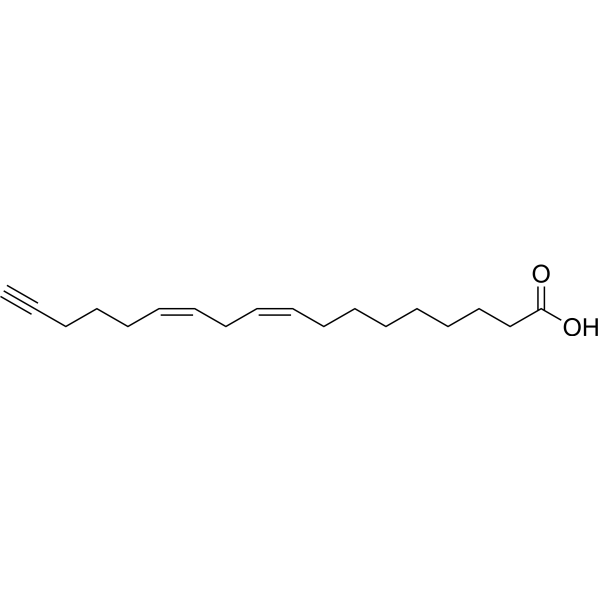Search Result
Results for "
linoleic
" in MedChemExpress (MCE) Product Catalog:
4
Biochemical Assay Reagents
9
Isotope-Labeled Compounds
| Cat. No. |
Product Name |
Target |
Research Areas |
Chemical Structure |
-
- HY-N0729
-
Linoleic acid
Maximum Cited Publications
10 Publications Verification
|
Endogenous Metabolite
|
Cardiovascular Disease
Metabolic Disease
Cancer
|
|
Linoleic acid is a common polyunsaturated (PUFA) found in plant-based oils, nuts and seeds. Linoleic acid is a part of membrane phospholipids, and functions as a structural component to maintain a certain level of membrane fluidity of the transdermal water barrier of the epidermis. Linoleic acid induces red blood cells and hemoglobin damage via oxidative mechanism .
|
-

-
- HY-N0729S
-
|
|
Isotope-Labeled Compounds
Endogenous Metabolite
|
Cardiovascular Disease
Metabolic Disease
|
|
Linoleic Acid-d4 is the deuterium labeled Linoleic acid. Linoleic acid is a common polyunsaturated (PUFA) found in plant-based oils, nuts and seeds. Linoleic acid is a part of membrane phospholipids, and functions as a structural component to maintain a certain level of membrane fluidity of the transdermal water barrier of the epidermis. Linoleic acid induces red blood cells and hemoglobin damage via oxidative mechanism [1][2].
|
-

-
- HY-110406A
-
|
13-Hydroperoxylinoleic acid; linoleic acid 13-hydroperoxide
|
Others
|
Others
|
|
(±)13-HpODE (13-hydroperoxylinoleic acid) is a racemic mixture of hydroperoxides, which is produced by the oxidation of linoleic acid by lipoxygenase .
|
-
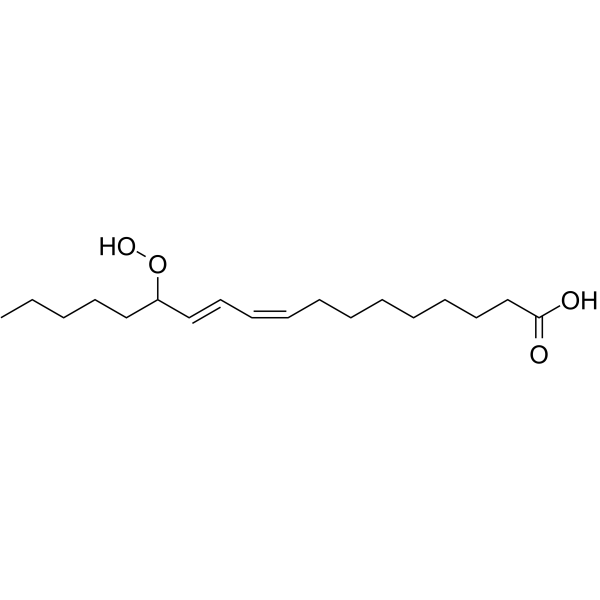
-
- HY-N0729R
-
|
|
Endogenous Metabolite
|
Cardiovascular Disease
Metabolic Disease
Cancer
|
|
Linoleic acid (Standard) is the analytical standard of Linoleic acid. This product is intended for research and analytical applications. Linoleic acid is a common polyunsaturated (PUFA) found in plant-based oils, nuts and seeds. Linoleic acid is a part of membrane phospholipids, and functions as a structural component to maintain a certain level of membrane fluidity of the transdermal water barrier of the epidermis. Linoleic acid induces red blood cells and hemoglobin damage via oxidative mechanism .
|
-
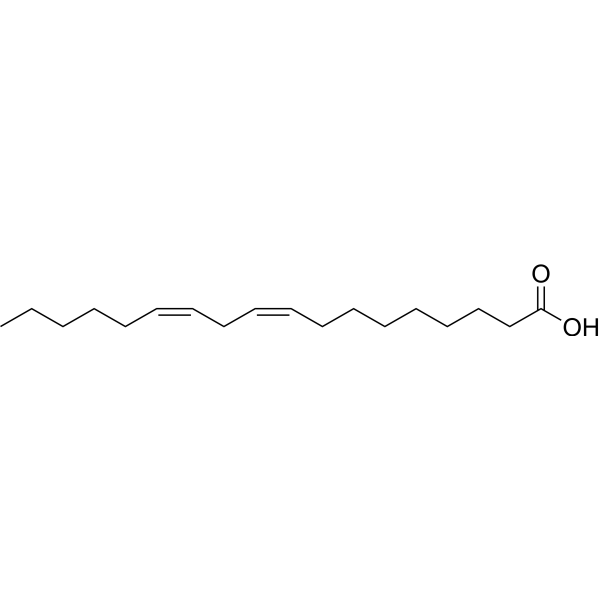
-
- HY-N0729S1
-
|
|
Endogenous Metabolite
|
Cardiovascular Disease
Metabolic Disease
|
|
Linoleic acid-d11 is the deuterium labeled Linoleic acid. Linoleic acid is a common polyunsaturated (PUFA) found in plant-based oils, nuts and seeds. Linoleic acid is a part of membrane phospholipids, and functions as a structural component to maintain a certain level of membrane fluidity of the transdermal water barrier of the epidermis. Linoleic acid induces red blood cells and hemoglobin damage via oxidative mechanism [1][2].
|
-

-
- HY-N0729S4
-
|
|
Isotope-Labeled Compounds
|
Cardiovascular Disease
Metabolic Disease
|
|
Linoleic Acid-d5 is the deuterium labeled Linoleic acid. Linoleic acid is a common polyunsaturated (PUFA) found in plant-based oils, nuts and seeds. Linoleic acid is a part of membrane phospholipids, and functions as a structural component to maintain a certain level of membrane fluidity of the transdermal water barrier of the epidermis. Linoleic acid induces red blood cells and hemoglobin damage via oxidative mechanism .
|
-

-
- HY-N0729S2
-
|
|
Endogenous Metabolite
|
Cardiovascular Disease
Metabolic Disease
|
|
Linoleic acid- 13C18 is the 13C labeled Linoleic acid. Linoleic acid is a common polyunsaturated (PUFA) found in plant-based oils, nuts and seeds. Linoleic acid is a part of membrane phospholipids, and functions as a structural component to maintain a certain level of membrane fluidity of the transdermal water barrier of the epidermis. Linoleic acid induces red blood cells and hemoglobin damage via oxidative mechanism [1][2].
|
-

-
- HY-N0729S3
-
|
|
Endogenous Metabolite
|
Cardiovascular Disease
Metabolic Disease
|
|
Linoleic acid- 13C1 is the 13C labeled Linoleic acid. Linoleic acid is a common polyunsaturated (PUFA) found in plant-based oils, nuts and seeds. Linoleic acid is a part of membrane phospholipids, and functions as a structural component to maintain a certain level of membrane fluidity of the transdermal water barrier of the epidermis. Linoleic acid induces red blood cells and hemoglobin damage via oxidative mechanism [1][2].
|
-

-
- HY-N0729S5
-
|
Deulinoleic acid
|
Endogenous Metabolite
|
Metabolic Disease
|
|
Linoleic Acid-d2 is the deuterium labeled Linoleic acid. Linoleic acid is a common polyunsaturated (PUFA) found in plant-based oils, nuts and seeds. Linoleic acid is a part of membrane phospholipids, and functions as a structural component to maintain a certain level of membrane fluidity of the transdermal water barrier of the epidermis. Linoleic acid induces red blood cells and hemoglobin damage via oxidative mechanism .
|
-
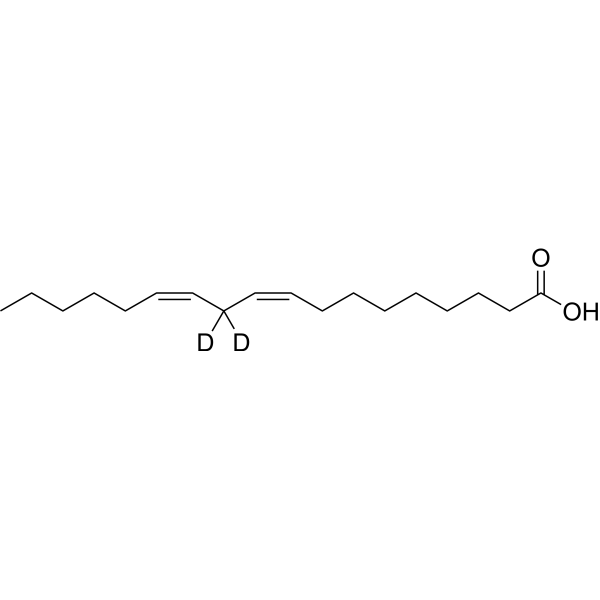
-
- HY-N1481S
-
-

-
- HY-N7848
-
|
linoleic acid amide
|
Others
|
Metabolic Disease
|
|
Linoleamide is a linoleic acid amide. Linoleamide regulates Ca (II) ?ux and inhibits the erg current .
|
-
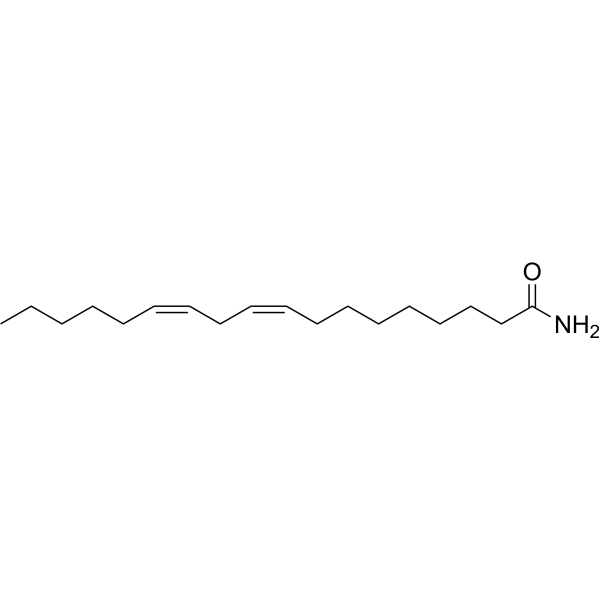
-
- HY-W013812
-
|
linoleic Acid ethyl ester; Mandenol
|
Others
|
Cardiovascular Disease
|
Ethyl linoleate (Linoleic Acid ethyl ester) inhibit the development of atherosclerotic lesions and the expression of inflammatory mediators .
|
-
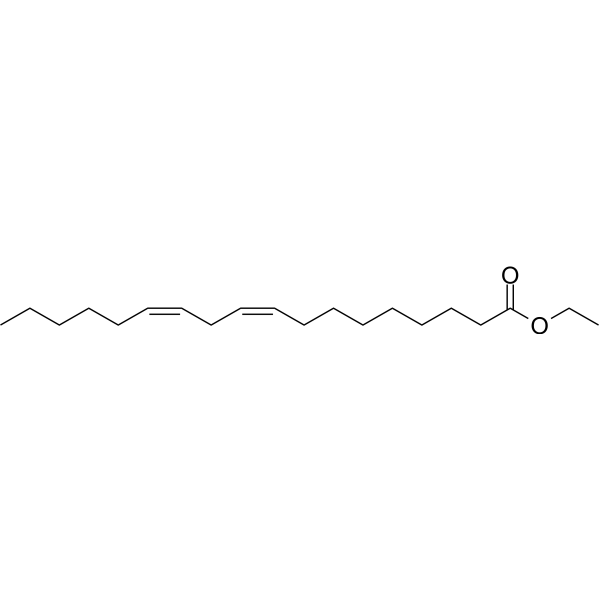
-
- HY-W013812S2
-
|
linoleic Acid ethyl ester-d2; Mandenol-d2
|
Isotope-Labeled Compounds
|
Cardiovascular Disease
|
|
Ethyl linoleate-d2 (Linoleic Acid ethyl ester-d2; Mandenol-d2) is the deuterium labeled Ethyl linoleate (HY-W013812). Ethyl linoleate (Linoleic Acid ethyl ester) inhibit the development of atherosclerotic lesions and the expression of inflammatory mediators .
|
-
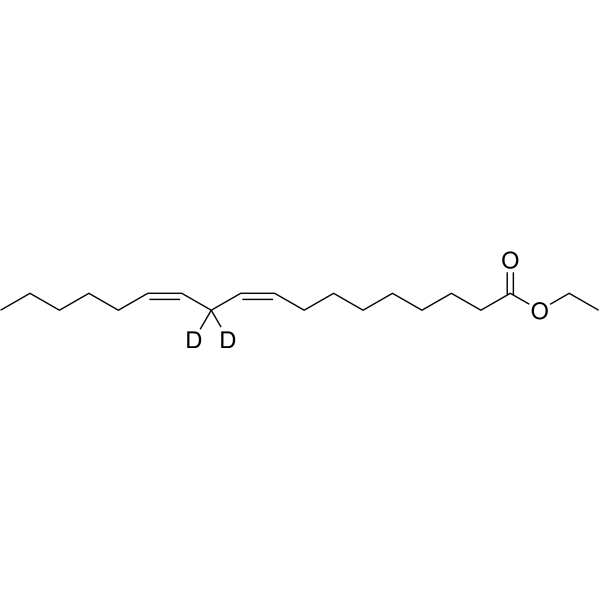
-
- HY-W127420
-
|
linoleic acid isopropyl ester
|
Biochemical Assay Reagents
|
Others
|
|
Isopropyl Linoleate is a biochemical reagent that can be used as a biological material or organic compound for life science related research.
|
-
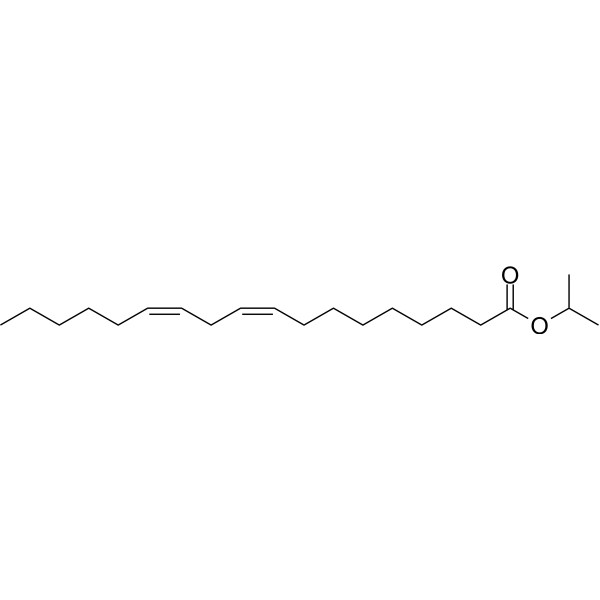
-
- HY-W013812S
-
|
linoleic Acid-13C18 ethyl ester; Mandenol-13C18
|
Isotope-Labeled Compounds
|
Cardiovascular Disease
|
Ethyl linoleate- 13C18 is the 13C labeled Ethyl linoleate. Ethyl linoleate inhibit the development of atherosclerotic lesions and the expression of inflammatory mediators[1].
|
-

-
- HY-120891
-
-
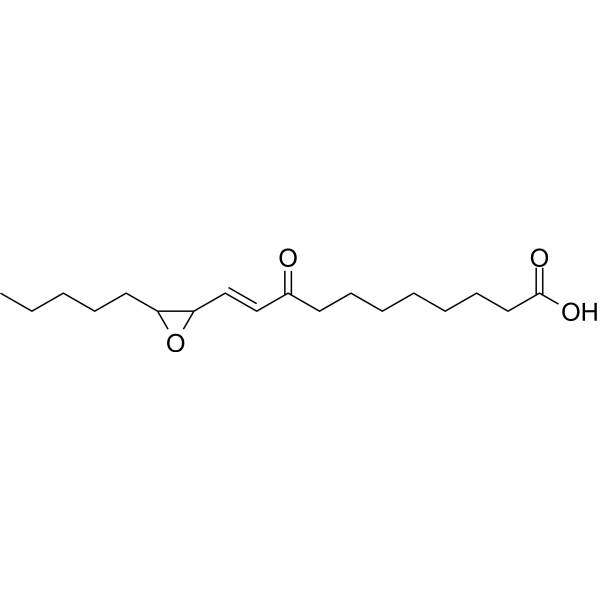
-
- HY-113102A
-
|
|
Endogenous Metabolite
|
Cancer
|
|
9(E),11(E)-Octadecadienoic acid is an isomer of conjugated linoleic acid (CLA). Conjugated linoleic acid is a fatty acid with potentially beneficial physiological and anticarcinogenic effects .
|
-

-
- HY-113102B
-
|
|
Endogenous Metabolite
|
Cancer
|
|
9(Z),11(Z)-octadecadienoic acid is an isomer of linoleic acid and has antitumor activity (EC 50 = 446.1 µM) .
|
-
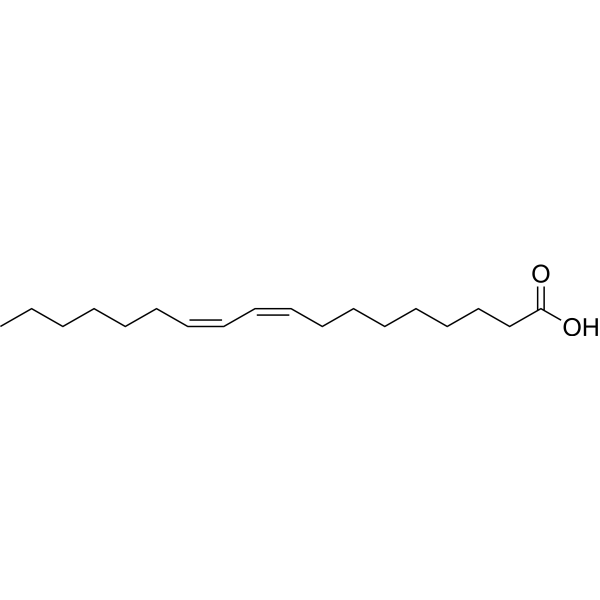
-
- HY-120109
-
|
|
Endogenous Metabolite
|
Cancer
|
|
13-HODE methyl ester, a racemic mixture of 13(R)-HODE methyl ester and 13(S)-HODE methyl ester, is a 15-lipoxygenase metabolite of Linoleic acid .
|
-
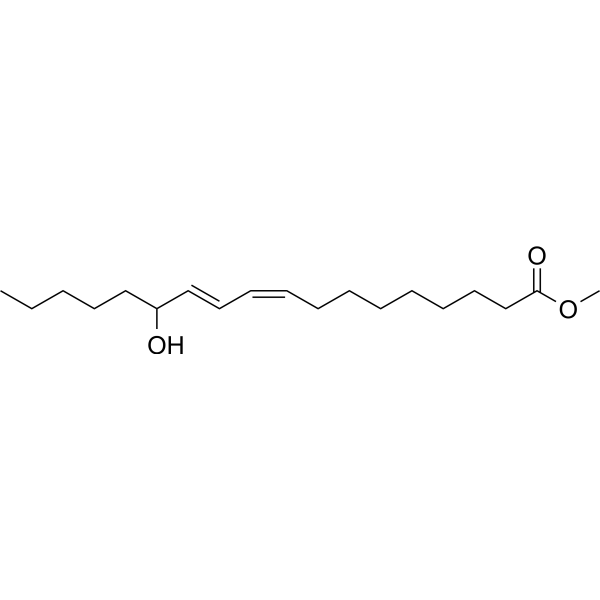
-
- HY-116768
-
|
10E,12Z-CLA Methyl ester; Methyl 10(E),12(Z)-octadecadienoate methyl ester; (10E,12Z)-SFE 19:2
|
Biochemical Assay Reagents
|
Others
|
|
10(E),12(Z)-Conjugated linoleic acid methyl ester (10E,12Z-CLA Methyl ester; Methyl 10(E),12(Z)-octadecadienoate methyl ester; SFE 19:2) is derivative of conjugated linoleic acid. 10(E),12(Z)-Conjugated linoleic acid methyl ester is utilized in the quantification of 10(E),12(Z)-conjugated linoleic acid .
|
-

-
- HY-N8276
-
|
9a,12a-Octadecadiynoic acid
|
Lipoxygenase
|
Metabolic Disease
Inflammation/Immunology
|
|
Ro 3-1314 (9a,12a-Octadecadiynoic acid) is a plant lipoxygenase inhibitor. Ro 3-1314 is a linoleic acid metabolism inhibitor. Ro 3-1314 stimulates the antigen-induced contraction of guinea-pig tracheal spirals and the immunological release of slow reacting substance of anaphylaxis (SRS-A) from actively sensitized guinea-pig lung fragments .
|
-

-
- HY-P2976
-
|
LOX
|
Endogenous Metabolite
|
Others
|
|
Lipoxygenase, general (LOX) is a dioxygenase, is often used in biochemical studies. Lipoxygenase, general catalyzes the formation of corresponding hydroperoxides from polyunsaturated fatty acids such as linoleic acid and arachidonic acid .
|
-

-
- HY-143791
-
|
|
Lipoxygenase
|
Inflammation/Immunology
|
|
ALOX15-IN-2 (compound 8a) is a potent inhibitor of the linoleate oxygenase activity of rabbit and human ALOX15 with IC50s of 1.55 and 2.79 μM for ALOX15 0rthologs linoleic acid (LA) and arachidonic acid (AA), respectively .
|
-

-
- HY-131670
-
|
|
Others
|
Inflammation/Immunology
|
|
(±)9,10-DiHOME is the racemate of 9,10-DiHOME. 9,10-DiHOME is a leukotoxin derivative of linoleic acid diol that has been reported to be toxic in human's tissue preparations, and is produced by inflammatory leukocytes such as neutrophils and macrophages .
|
-
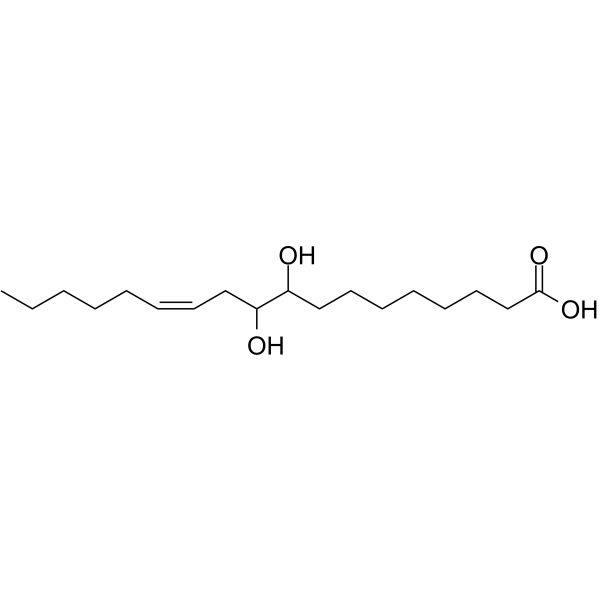
-
- HY-143787
-
|
|
Lipoxygenase
|
Inflammation/Immunology
|
|
ALOX15-IN-1 (compound 8b) is a potent inhibitor of the linoleate oxygenase activity of rabbit and human ALOX15 with IC50s of 0.04 and 2.06 μM for ALOX15 0rthologs linoleic acid (LA) and arachidonic acid (AA), respectively .
|
-
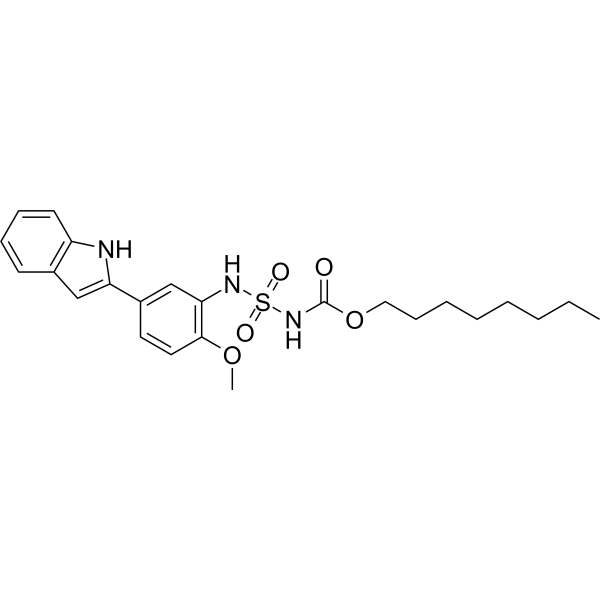
-
- HY-118149A
-
|
|
Bacterial
Fungal
Parasite
|
Infection
|
|
(±)9-HpODE is a long chain lipid hydroperoxide, is a product of linoleic acid peroxidation. (±)9-HpODE can induce oxidation of intracellular glutathione (GSH). (±)9-HpODE also exhibits antimicrobial activity against various fungal and bacterial pathogens .
|
-
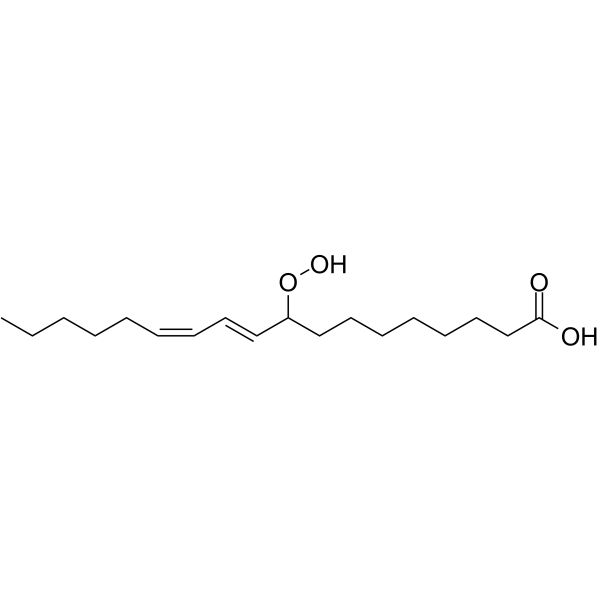
-
- HY-113884B
-
|
13(S)-HODE
|
PPAR
Mitochondrial Metabolism
|
Inflammation/Immunology
Cancer
|
|
(S)-Coriolic acid (13(S)-HODE), the product of 15-lipoxygenase (15-LOX) metabolism of linoleic acid, functions as the endogenous ligand to activate PPARγ. (S)-Coriolic acid is an important intracellular signal agent and is involved in cell proliferation and differentiation in various biological systems. (S)-Coriolic acid induces mitochondrial dysfunction and airway epithelial injury .
|
-

-
- HY-19996
-
|
|
Free Fatty Acid Receptor
|
Metabolic Disease
|
|
AH-7614 is a potent and selective FFA4 (GPR120) antagonist, with pIC50s of 7.1, 8.1, and 8.1 for human, mouse, and rat FFA4, respectively. AH-7614 has selectivity for FFA4 over FFA1 (pIC50<4.6). AH-7614 is able to block effects of both the polyunsaturated ω-6 fatty acid linoleic acid and the synthetic FFA4 agonist .
|
-
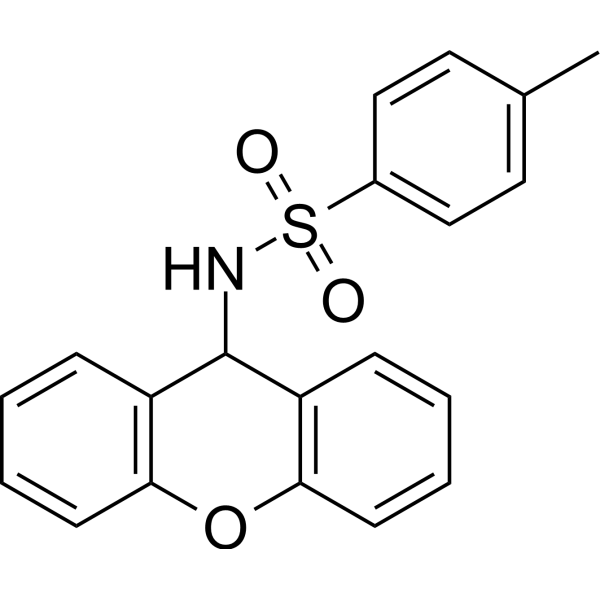
-
- HY-108599
-
DCP-LA
2 Publications Verification
FR236924
|
PKC
CaMK
Phosphatase
Apoptosis
|
Neurological Disease
|
|
DCP-LA (FR236924), a linoleic acid derivative, selectively and directly activates PKCε. DCP-LA activates Ca( 2+)/calmodulin-dependent protein kinase II (CaMKII) and inhibits protein phosphatase-1 (PP-1) to stimulate AMPA receptor exocytosis. DCP-LA inhibits activation of caspase-3/-9 and protects neurons at least in part from oxidative stress-induced apoptosis .
|
-

-
- HY-113162
-
-
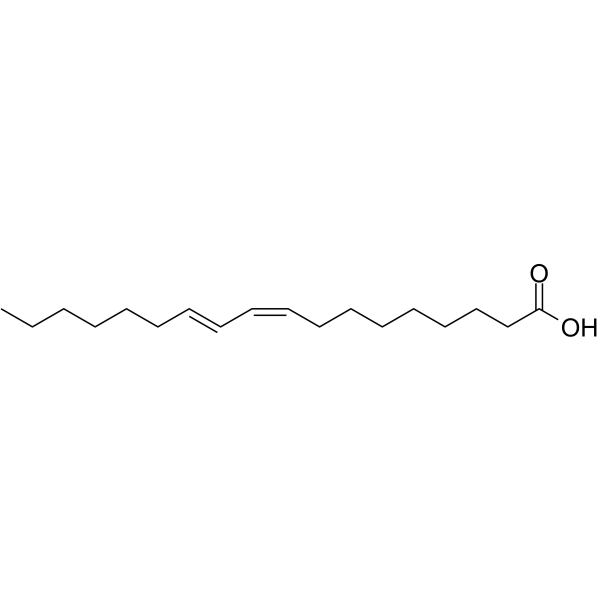
-
- HY-W005627
-
|
|
Others
|
Metabolic Disease
|
|
Linoleyl alcohol, a structural analog of Linoleic acid with no a-carboxyl group, is a fatty alcohol .
|
-

-
- HY-113427
-
|
|
Endogenous Metabolite
|
Others
|
|
trans-Vaccenic acid is a precursor for the synthesis of saturated fatty acid in the rumen and of conjugated linoleic acid (CLA) at the tissue level.
|
-
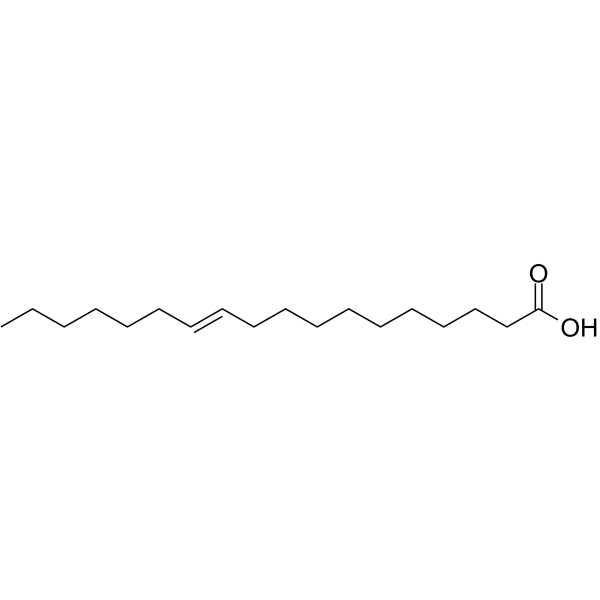
-
- HY-118149
-
|
9-D-Hydroperoxylinoleic acid
|
Endogenous Metabolite
|
Metabolic Disease
|
|
9(S)-HpODE is produced by the action of arachidonate 5-LO on linoleic acid. It can be further metabolized by potato hydroperoxide dehydratase to colneleic acid.
|
-

-
- HY-120978
-
|
ω-3 Arachidonic acid methyl ester; (all-Z)-8,11,14,17-Eicosatetraenoic acid methyl ester
|
Biochemical Assay Reagents
|
Others
|
|
omega-3 Arachidonic Acid methyl ester, mainly docosahexaenoic acid, eicosapentaenoic acid and α-Linoleic acid, represented by linoleic acid, is an essential dietary nutrient required for normal growth and development.Omega-3Methyl arachidonic acid is a rare fatty acid Omega-3Neutral fat-soluble form of arachidonic acid. Omega-3Fatty acids, as a group, were associated with reduced inflammation and autoimmune activity, as well as reduced thrombosis and platelet activation.
|
-

-
- HY-113884A
-
|
(±)-13-HODE
|
Endogenous Metabolite
|
Metabolic Disease
|
|
(±)13-HODE is one of the two racemic monohydroxy fatty acids resulting from the non-enzymatic oxidation of linoleic acid. It is the principle hydroxylated fatty acid in human psoriatic skin scales, with a mean concentration of 17 ng/mg.
|
-

-
- HY-113545
-
|
9(R)-Hydroxyoctadecadienoic acid
|
Endogenous Metabolite
|
Metabolic Disease
|
|
9(R)-HODE is a monohydroxy fatty acid and metabolite of linoleic acid. It is formed from linoleic acid by COX and lipoxygenase (LO).9(R)-HODE induces chemotaxis, increases the levels of chemokine (C-C motif) receptor 9 (CCR9) and chemokine (C-X-C motif) receptor 4 (CXCR4), and inhibits IL-6 release in primary human monocytes. It inhibits CD3α- and CD28-induced proliferation of isolated human peripheral blood lymphocytes when used at a concentration of 25 μg/mL.
|
-

-
- HY-N10002
-
|
|
Phosphatase
Glucosidase
|
Metabolic Disease
|
|
Caffeoyltryptophan is a competitive PTP1B inhibitor, with an IC50 of 16.99 μM. Caffeoyltryptophan can also inhibit α-glucosidase, linoleic acid peroxidation and haemolysis. Caffeoyltryptophan can be used for the research of type 2 diabetes .
|
-
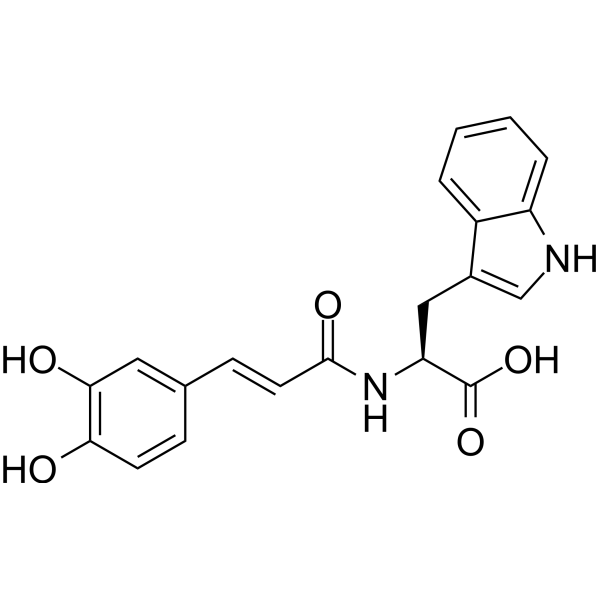
-
- HY-113455
-
|
Alpha-dimorphecolic acid
|
Apoptosis
Endogenous Metabolite
|
Cancer
|
|
9S-HODE (Alpha-dimorphecolic acid) is an octadecadienoic acid and the main active derivative of linoleic acid, which can reduce the viability of HL-60 cells and induce apoptosis. 9S-HODE is rich in lipid peroxidation (LPO) products and is almost an ideal marker for LPO .
|
-
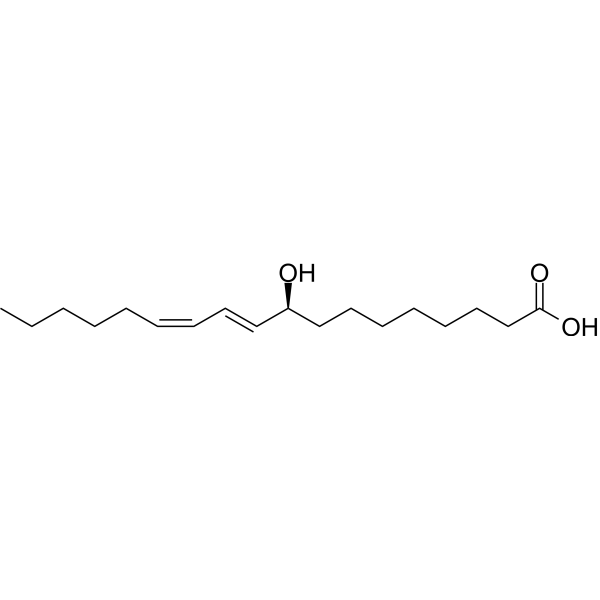
-
- HY-N7953
-
|
OOL; TG(18:1/18:1/18:2); TG(54:4)
|
Endogenous Metabolite
|
Metabolic Disease
|
|
1,2-Dioleoyl-3-linoleoyl-rac-glycerol (OOL) is a triacylglycerol containing oleic acid at the sn-1 and sn-2 positions and linoleic acid at the sn-3 position. It is found in a variety of seed and vegetable oils, including pumpkin seed, olive, and sesame oils.
|
-

-
- HY-N7539
-
|
|
Others
|
Metabolic Disease
|
|
Cognac oil, mainly found in wine lees, has unique fatty acid profiles, including Palmitic acid (59.26%), Linoleic acid (11.92%), Myristic acid (8.97%), Oleic acid (8.3%) and other fatty acids. Cognac oil leads to a general increase in the permeation of R6G (Rhodamine 6G) across all the membranes .
|
-
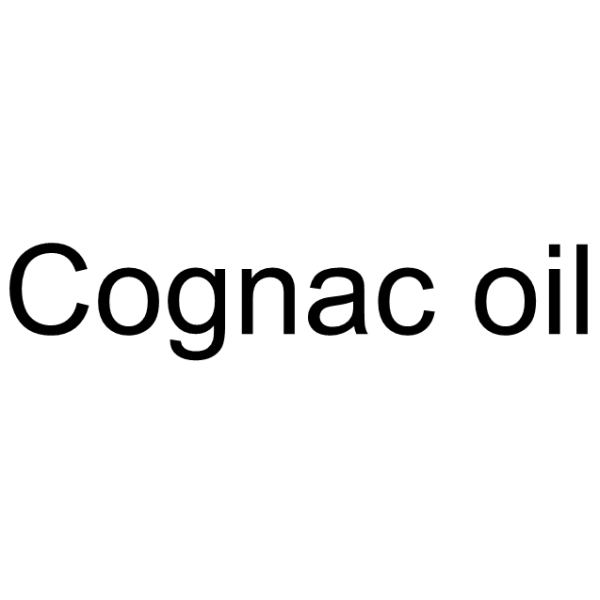
-
- HY-141469
-
|
HPA; Heneicosapentaenoic acid methyl ester
|
Others
|
Cardiovascular Disease
Neurological Disease
|
|
6,9,12,15,18-Heneicosapentaenoic acid (HPA; Heneicosapentaenoic acid methyl ester) inhibits the conversion of α-linoleic acid into Arachidonic acid (HY-109590) in hepatoma cells, the activation of prostaglandin H synthase and thromboxane synthesis in isolated platelets. 6,9,12,15,18-Heneicosapentaenoic acid is weak inducer of acyl-CoA oxidase in hepatoma cells .
|
-
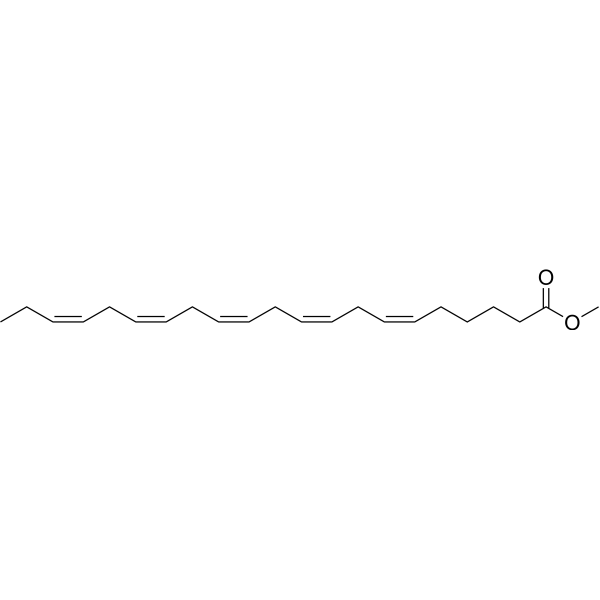
-
- HY-W778471
-
|
DG(18:2/0:0/18:3); 1-Linolein-3-α-Linolenin; 1-Linolein-3-Linolenin
|
Endogenous Metabolite
|
Metabolic Disease
|
|
1-Linoleoyl-3-α-linolenoyl-rac-glycerol is a diacylglycerol that contains linoleic acid (HY-N0729) at the sn-1 position and α-linolenic acid (HY-N0728) at the sn-3 position. It has been found in olive oil subjected to lipase-catalyzed glycerolysis with immobilized lipase B from C. antarctica.
|
-

-
- HY-142971
-
|
1-Myristin-2-Linolein-3-Olein; TG(14:0/18:2/18:1)
|
Endogenous Metabolite
|
Metabolic Disease
|
|
1-Myristoyl-2-linoleoyl-3-oleoyl-rac-glycerol is a triacylglycerol that contains myristic acid (HY-N2041), linoleic acid (HY-N0729), and oleic acid (HY-N1446) at the sn-1, sn-2, and sn-3 positions, respectively. It has been found in mature human milk, infant formula fats, and butterfat.
|
-

-
- HY-101906
-
|
|
Free Fatty Acid Receptor
Apoptosis
|
Metabolic Disease
|
|
DC260126 is a potent antagonist of GPR40 (FFAR1). DC260126 dose-dependently inhibits GPR40-mediated Ca 2+ elevations stimulated by linoleic acid, oleic acid, palmitoleic acid and lauric acid (IC50: 6.28, 5.96, 7.07, 4.58 μM, respectively) . DC260126 could protect MIN6 β cells from palmitate-induced ER stress and apoptosis .
|
-
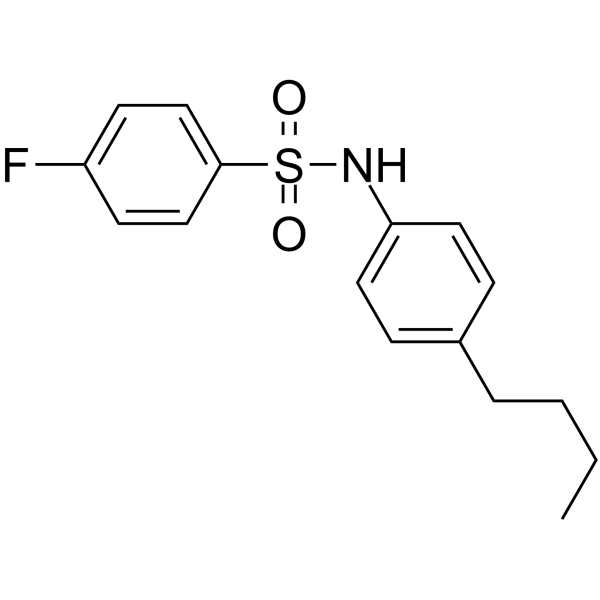
-
- HY-113884
-
|
13(R)-HODE
|
Endogenous Metabolite
|
Metabolic Disease
|
|
13(R)-HODE is the opposite enantiomer of the 13(S)-HODE produced when linoleic acid is incubated with soybean lipoxygenase. The presence of 13(R)-HODE in the supernatants and membranes of cultured bovine endothelial cells has been attributed to COX metabolism.1 13(R)-HODE is a weak (IC50=2.7 μM) inhibitor of U-46619-induced platelet aggregation.
|
-

-
- HY-W643167
-
|
Glycerol Tritridecanoyl; 13:0 TAG; 13:0/13:0/13:0-TG
|
Others
|
Infection
|
|
1,2,3-Tritridecanoyl glycerol is a synthetic triacylglycerol that contains tridecanoic acid in the sn-1, sn-2, and sn-3 positions. It has been used as a standard for the relative quantification of triacylglycerols in C. elegans fat stores. It has also been used as an internal standard for the quantification of triacylglycerols in the serum and liver of adult rat offspring receiving dietary conjugated linoleic acids during and after gestation.
|
-

-
- HY-117168
-
|
|
Endogenous Metabolite
|
Metabolic Disease
|
|
1,2-Dilinoleoyl-sn-glycerol is a diacylglycerol (DAG) with linoleic acid (HY-N0729) (18:2) side chains attached at both the sn-1 and sn-2 positions. It has been found as a component of phosphatidic acid in rat liver mitochondria and in spinach chloroplast membranes. 1,2-Dilinoleoyl-sn-glycerol is upregulated in some pregnant women and has been used as a biomarker to predict later preeclampsia in early pregnancy.
|
-

-
- HY-W753927
-
|
C18:2(9E,12Z); C18:2 n-6
|
Endogenous Metabolite
|
Metabolic Disease
|
|
9(E),12(Z)-Octadecadienoic acid is an ω-6 polyunsaturated fatty acid and an isomer of linoleic acid (HY-N0729) that contains a trans double bond at the C9 position. It has been found as a minor component of bovine milk fat and in partially hydrogenated vegetable oils. 9(E),12(Z)-Octadecadienoic acid levels increase in rabbit meat following supplementation with heated sunflower oil, α-tocopheryl acetate, and zinc.
|
-

-
- HY-W679754
-
|
PFTrDA
|
Others
|
Infection
|
|
Perfluorotridecanoic acid (PFTrDA) is a perfluoroalkyl substance (PFAS). Embryo larval exposure of PFTrDA induces yolk sac edema and increases mRNA expression of thyroid hormone synthesis genes, including tshβ, in zebrafish when used at concentrations of 0.1 and 0.3 mg/L, respectively. PFTrDA (10 mg/kg) decreases serum testosterone and luteinizing hormone levels, testis palmitic acid, linoleic acid, and oleic acid levels, and the number of Leydig cells in rats in late puberty. Maternal plasma levels of PFTrDA during gestation are positively associated with the development of eczema in female, but not male, infants, and liver levels of PFTrDA are higher in cancerous human livers compared with non-cancerous human livers. It has been found in marine mammals.
|
-

-
- HY-N7833
-
|
Heneicosapentaenoic acid
|
Biochemical Assay Reagents
|
Others
|
|
Heneicosapentaenoic Acid (HPA) is a 21:5 omega-3 fatty acid found in trace amounts in the green alga B. pennata and in fish oils. Its chemical composition is similar to eicosapentaenoic acid (EPA), except that a carbon is extended at the carboxy terminus, placing the first double bond at the δ6 position. HPA can be used to study the importance of double bond position in omega-3 fatty acids. It incorporates phospholipids and triacylglycerols in vivo with the same efficiency as EPA and docosahexaenoic acid, and exhibits a strong inhibitory effect on the synthesis of arachidonic acid from linoleic acid. HPA is a poor substrate for prostaglandin H synthase (PGHS) (cyclooxygenase) and 5-lipoxygenase, but retains the ability to rapidly inactivate PGHS.
|
-
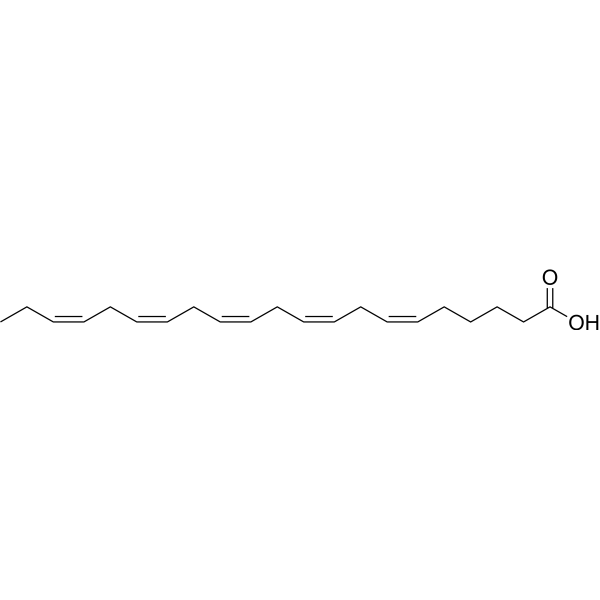
- HY-136410
-
|
|
Endogenous Metabolite
|
Metabolic Disease
|
|
4-hydroxy Nonenal Mercapturic Acid (4-HNE) is generated by the peroxidation of common ω-6 polyunsaturated fatty acids (PUFAs) such as linoleic acid, DGLA, and arachidonic acid. 4-hydroxy Nonenal Mercapturic Acid is rapidly cleared from plasma and enters the enterohepatic circulation in rats as a glutathione conjugate. Approximately two-thirds of 4-hydroxy Nonenal Mercapturic Acid is excreted in the urine within 48 hours, primarily as mercapturic acid conjugates. Approximately half of the metabolites are C-1 aldehydes of 4-hydroxy Nonenal Mercapturic Acid that are reduced to alcohols. The remainder are C-1 aldehydes or have been oxidized to C-1 carboxylic acids. These aldehydes and carboxylic acids can also form gamma-lactols and gamma-lactones, respectively, resulting in at least four or five final urinary metabolites of 4-HNE in vivo.
|
-

| Cat. No. |
Product Name |
Type |
-
- HY-W127420
-
|
linoleic acid isopropyl ester
|
Biochemical Assay Reagents
|
|
Isopropyl Linoleate is a biochemical reagent that can be used as a biological material or organic compound for life science related research.
|
-
- HY-W760733
-
|
|
Biochemical Assay Reagents
|
|
2,4-Decadienal is a toxic aldehyde produced by the oxidation of linoleic acid-rich oils. 2,4-decadienal can be used as an alternative oxidation indicator for linoleic acid-rich oils .
|
-
- HY-120978
-
|
ω-3 Arachidonic acid methyl ester; (all-Z)-8,11,14,17-Eicosatetraenoic acid methyl ester
|
Biochemical Assay Reagents
|
|
omega-3 Arachidonic Acid methyl ester, mainly docosahexaenoic acid, eicosapentaenoic acid and α-Linoleic acid, represented by linoleic acid, is an essential dietary nutrient required for normal growth and development.Omega-3Methyl arachidonic acid is a rare fatty acid Omega-3Neutral fat-soluble form of arachidonic acid. Omega-3Fatty acids, as a group, were associated with reduced inflammation and autoimmune activity, as well as reduced thrombosis and platelet activation.
|
-
- HY-N7833
-
|
Heneicosapentaenoic acid
|
Biochemical Assay Reagents
|
|
Heneicosapentaenoic Acid (HPA) is a 21:5 omega-3 fatty acid found in trace amounts in the green alga B. pennata and in fish oils. Its chemical composition is similar to eicosapentaenoic acid (EPA), except that a carbon is extended at the carboxy terminus, placing the first double bond at the δ6 position. HPA can be used to study the importance of double bond position in omega-3 fatty acids. It incorporates phospholipids and triacylglycerols in vivo with the same efficiency as EPA and docosahexaenoic acid, and exhibits a strong inhibitory effect on the synthesis of arachidonic acid from linoleic acid. HPA is a poor substrate for prostaglandin H synthase (PGHS) (cyclooxygenase) and 5-lipoxygenase, but retains the ability to rapidly inactivate PGHS.
|
| Cat. No. |
Product Name |
Category |
Target |
Chemical Structure |
| Cat. No. |
Product Name |
Chemical Structure |
-
- HY-N0729S
-
|
|
|
Linoleic Acid-d4 is the deuterium labeled Linoleic acid. Linoleic acid is a common polyunsaturated (PUFA) found in plant-based oils, nuts and seeds. Linoleic acid is a part of membrane phospholipids, and functions as a structural component to maintain a certain level of membrane fluidity of the transdermal water barrier of the epidermis. Linoleic acid induces red blood cells and hemoglobin damage via oxidative mechanism [1][2].
|
-

-
- HY-N0729S1
-
|
|
|
Linoleic acid-d11 is the deuterium labeled Linoleic acid. Linoleic acid is a common polyunsaturated (PUFA) found in plant-based oils, nuts and seeds. Linoleic acid is a part of membrane phospholipids, and functions as a structural component to maintain a certain level of membrane fluidity of the transdermal water barrier of the epidermis. Linoleic acid induces red blood cells and hemoglobin damage via oxidative mechanism [1][2].
|
-

-
- HY-N0729S4
-
|
|
|
Linoleic Acid-d5 is the deuterium labeled Linoleic acid. Linoleic acid is a common polyunsaturated (PUFA) found in plant-based oils, nuts and seeds. Linoleic acid is a part of membrane phospholipids, and functions as a structural component to maintain a certain level of membrane fluidity of the transdermal water barrier of the epidermis. Linoleic acid induces red blood cells and hemoglobin damage via oxidative mechanism .
|
-

-
- HY-N0729S2
-
|
|
|
Linoleic acid- 13C18 is the 13C labeled Linoleic acid. Linoleic acid is a common polyunsaturated (PUFA) found in plant-based oils, nuts and seeds. Linoleic acid is a part of membrane phospholipids, and functions as a structural component to maintain a certain level of membrane fluidity of the transdermal water barrier of the epidermis. Linoleic acid induces red blood cells and hemoglobin damage via oxidative mechanism [1][2].
|
-

-
- HY-N0729S3
-
|
|
|
Linoleic acid- 13C1 is the 13C labeled Linoleic acid. Linoleic acid is a common polyunsaturated (PUFA) found in plant-based oils, nuts and seeds. Linoleic acid is a part of membrane phospholipids, and functions as a structural component to maintain a certain level of membrane fluidity of the transdermal water barrier of the epidermis. Linoleic acid induces red blood cells and hemoglobin damage via oxidative mechanism [1][2].
|
-

-
- HY-N0729S5
-
|
|
|
Linoleic Acid-d2 is the deuterium labeled Linoleic acid. Linoleic acid is a common polyunsaturated (PUFA) found in plant-based oils, nuts and seeds. Linoleic acid is a part of membrane phospholipids, and functions as a structural component to maintain a certain level of membrane fluidity of the transdermal water barrier of the epidermis. Linoleic acid induces red blood cells and hemoglobin damage via oxidative mechanism .
|
-

-
- HY-N1481S
-
|
|
|
Linoleic Acid-d11 methyl ester is the deuterium labeled Linoleic Acid methyl ester[1].
|
-

-
- HY-W013812S2
-
|
|
|
Ethyl linoleate-d2 (Linoleic Acid ethyl ester-d2; Mandenol-d2) is the deuterium labeled Ethyl linoleate (HY-W013812). Ethyl linoleate (Linoleic Acid ethyl ester) inhibit the development of atherosclerotic lesions and the expression of inflammatory mediators .
|
-

-
- HY-W013812S
-
|
|
Ethyl linoleate- 13C18 is the 13C labeled Ethyl linoleate. Ethyl linoleate inhibit the development of atherosclerotic lesions and the expression of inflammatory mediators[1].
|
-

| Cat. No. |
Product Name |
|
Classification |
-
- HY-145469
-
|
|
|
Alkynes
|
|
Linoleic acid alkyne is an ω-alkyne derivative of Linoleic acid (HY-N0729). Linoleic acid alkyne can be used to synthesize other alkyne-containing products,such as glycerophospholipids, for click chemistry .
|
Your information is safe with us. * Required Fields.
Inquiry Information
- Product Name:
- Cat. No.:
- Quantity:
- MCE Japan Authorized Agent:


























































